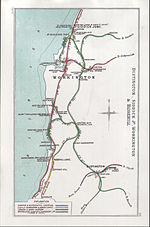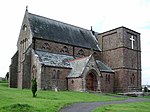Harrington railway station
1846 establishments in EnglandDfT Category F2 stationsFormer London and North Western Railway stationsNorth West England railway station stubsNorthern franchise railway stations ... and 4 more
Pages with no open date in Infobox stationRailway stations in CumbriaRailway stations in Great Britain opened in 1846Use British English from May 2013

Harrington railway station is a railway station serving the village of Harrington in Cumbria, England. It is on the Cumbrian Coast Line, which runs between Carlisle and Barrow-in-Furness. It is owned by Network Rail and managed by Northern Trains.
Excerpt from the Wikipedia article Harrington railway station (License: CC BY-SA 3.0, Authors, Images).Harrington railway station
Grecian Terrace,
Geographical coordinates (GPS) Address External links Nearby Places Show on map
Geographical coordinates (GPS)
| Latitude | Longitude |
|---|---|
| N 54.6136362 ° | E -3.5656096 ° |
Address
Harrington
Grecian Terrace
CA14 5QP , Salterbeck
England, United Kingdom
Open on Google Maps






